Blogs

Understanding Low Coefficient of Friction Materials: An In-Depth Tutorial
Introduction
In the realm of engineering and manufacturing, the coefficient of friction (COF) stands as a pivotal metric, influencing everything from mechanical efficiency to material longevity. As industries strive for greater operational efficiency, understanding the intricacies of low friction materials becomes essential.
These materials, characterized by their ability to minimize resistance, are not only crucial for enhancing performance but also for reducing wear and energy consumption across various applications.
This article delves into the fundamentals of COF, explores key types of low friction materials, and highlights their diverse applications in sectors such as automotive, aerospace, and medical devices.
By examining the benefits and challenges associated with selecting these materials, procurement managers can make informed decisions that align with the latest advancements in material science, ultimately driving innovation and sustainability in their operations.
Understanding the Coefficient of Friction: Basics and Importance
The coefficient of resistance (COF) is a fundamental metric that quantifies the opposition faced when one surface slides over another. Specifically, it is expressed as the ratio of the frictional force between two bodies to the force that presses them together. Understanding this concept is essential, as it plays a pivotal role in influencing wear rates, energy consumption, and the overall efficacy of mechanical systems.
Recent studies indicate that the average resistance angle at normal temperatures is approximately 29.3°, with a minimal deviation of 0.65° from the onshore resistance angle. A case study titled ‘Statistical Processing of Angle Dataset’ statistically analyzed angles from onshore and offshore regions, confirming normal distributions at a 95% confidence level and providing threshold values for angles that are crucial for future underground resource exploitation projects. Materials with a low coefficient of friction, such as polytetrafluoroethylene (PTFE), exhibit coefficients significantly lower than those of conventional materials.
This trait renders low coefficient of friction materials especially beneficial in numerous applications where reducing resistance can lead to improved operational efficiency and a longer component lifespan. As Professor Andreas Almqvist observed, minimizing resistance is crucial in numerous uses, including skiing, where it directly affects performance. By minimizing resistance, these substances assist in enhancing mechanical performance, thus promoting economical and sustainable engineering solutions.
Furthermore, the use of geomechanical models by Dung T.Q. et al. (2020) to identify open fractures in basement reservoirs illustrates the practical significance of COF in engineering contexts.
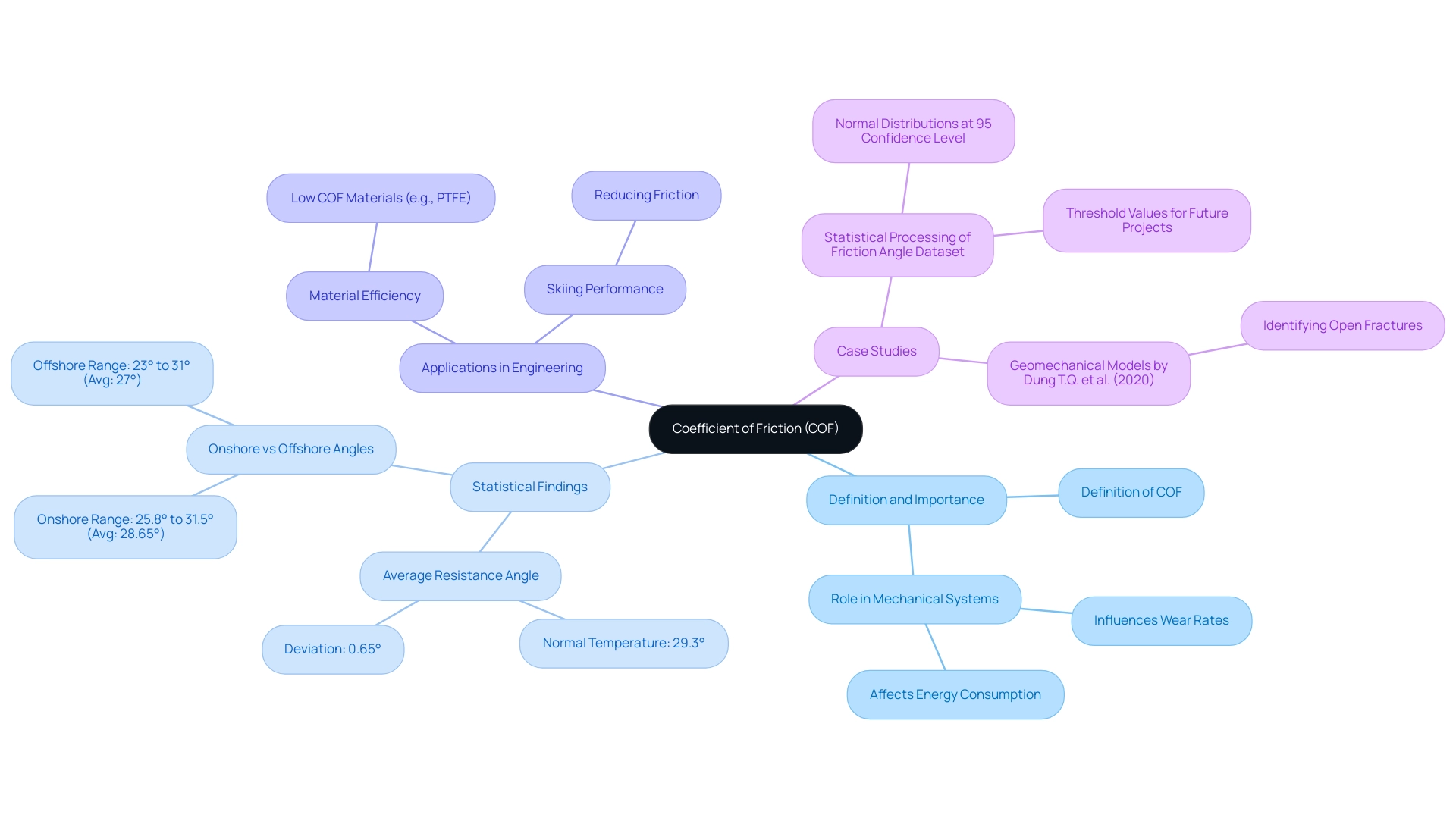
Exploring Low Friction Materials: Key Types and Their Applications
Low coefficient of friction materials and high-temperature insulation items are crucial for enhancing industrial applications, and understanding their specific characteristics is vital for efficient procurement. Key materials include:
- PTFE (Polytetrafluoroethylene) – Celebrated for its remarkable chemical resistance and low resistance properties, PTFE is widely employed in bearings, seals, and gaskets.
Its characteristics, including high strength, toughness, low water absorption, and flammability, render it especially appropriate for challenging environments like food processing, medical uses, and high-purity settings. Notably, Richard A. Pethrick emphasizes that the role of [absorbed water](https://sciencedirect.com/topics/earth-and-planetary-sciences/polytetrafluoroethylene) and the associated effects of clustering are critical factors in their performance, illustrating the importance of understanding PTFE’s behavior in various conditions. Additionally, PTFE exhibits two peaks at 533.0 eV and 535.3 eV, attributed to sulfonic acid and ether oxygen, providing a scientific basis for its performance.
A case study on PTFE highlights its exceptional properties, demonstrating its suitability for various environments, including food, medical, and high-purity applications.
UHMW (Ultra-High Molecular Weight Polyethylene) – A highly durable substance, UHMW offers outstanding wear resistance and minimal resistance, making it perfect for uses in chutes, rollers, and conveyor systems. Its market share continues to expand due to its robustness and effectiveness in high-load environments.
Graphite – Often utilized as a lubricant, graphite greatly minimizes resistance between moving components in machinery, improving performance and durability. Its unique properties make it a favorite in various mechanical applications.
Ceramics – Certain advanced ceramics that are classified as low coefficient of friction materials demonstrate low friction characteristics and are utilized in scenarios that necessitate high-temperature resistance, providing a dependable solution in extreme conditions.
Mica Tape Products – Our Mica Insulation Tape is designed for high-temperature resistance and electrical insulation, making it ideal for essential uses in electrical engineering. It guarantees reliability and durability across diverse uses, from household devices to industrial machinery. Additionally, specialized Mica Tape for electrical applications offers excellent flame resistance and dielectric strength, essential for safety in high-temperature and fire-sensitive environments.
The Mica Sheet Tape provides robust insulation for large flat surfaces and is commonly used in the manufacture of fire-resistant cables, as well as in the construction of coils and capacitors, making it suitable for aerospace and automotive sectors. Grasping these resources not only assists in choosing the best match for specific industrial requirements but also enables procurement managers to make informed choices that align with the latest advancements in science.
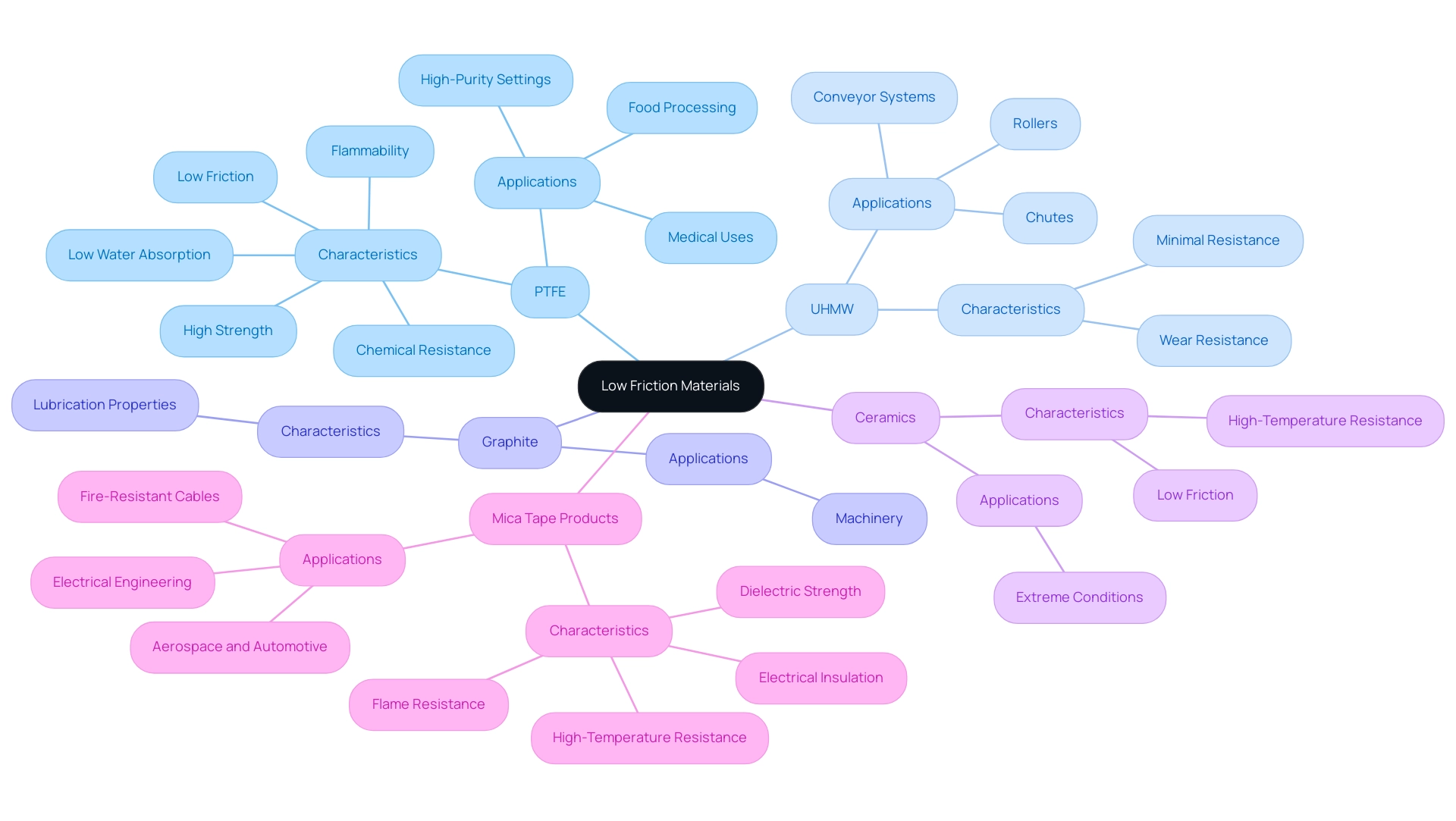
Applications of Low Friction Materials in Industry
Low resistance substances showcase their adaptability across various sectors, promoting innovation and effectiveness.
- Automotive – In the automotive sector, polytetrafluoroethylene (PTFE) is extensively utilized in fuel systems, bearings, and gaskets.
The use of low coefficient of friction materials results in decreased wear, thereby enhancing performance and prolonging the lifespan of essential components. Recent industry statistics suggest that low resistance substances have resulted in a 15% enhancement in fuel efficiency across different vehicle models, highlighting their considerable influence on automotive engineering.
- Medical Devices – Ultra-high-molecular-weight polyethylene (UHMW) has emerged as a pivotal material in the medical field, commonly found in surgical instruments and implants. The characteristics of low coefficient of friction materials, like UHMW, facilitate smoother operation and minimize wear, which is crucial for patient safety and device longevity. Furthermore, the integration of DOMADIA Oxygen Free Copper (OFE/OHFC) in critical medical components not only enhances conductivity but also ensures safety in explosive environments, making it a preferred choice in high-stakes scenarios.
Industry specialists highlight that the use of low resistance materials in medical uses can result in a decrease in operational failures by as much as 20%.
- In electronics, low coefficient of friction materials are used as low resistance coatings on various components to mitigate energy loss and enhance device lifespan.
This application is particularly relevant as manufacturers strive for more efficient devices in a market increasingly driven by sustainability.
- Aerospace – The aerospace industry employs high-performance ceramics in engines and other high-stress components.
These substances, specifically low coefficient of friction materials, are designed to endure severe conditions while reducing resistance to a minimum, a requirement for upholding performance and safety in flight operations. Alongside low resistance substances, Non-Sparking Tools serve an essential function in settings with explosive risk. These tools, constructed from substances that do not generate sparks, are crucial for maintaining safety in sectors like oil and gas, mining, and chemical manufacturing.
Their unique properties prevent ignition in volatile environments, making them indispensable for maintenance and operational tasks. As the Asia-Pacific area undergoes swift industrial growth, fueled by investments such as Google’s recent USD 2 billion pledge to Malaysia’s technological framework, the demand for low coefficient of friction materials and Non-Sparking Tools is set to increase considerably across these sectors. This growth is further supported by the construction sector’s expansion, as highlighted by Datuk Seri Alexander Nanta Linggi, who noted that the construction sector of Malaysia grew in 2023, with a total of 9,144 projects successfully implemented until September 2023.
With the growing need for machinery and equipment, the use of low coefficient of friction materials, along with Non-Sparking Tools, will be essential in improving performance and efficiency throughout these industries, especially in scenarios that necessitate strict safety measures.
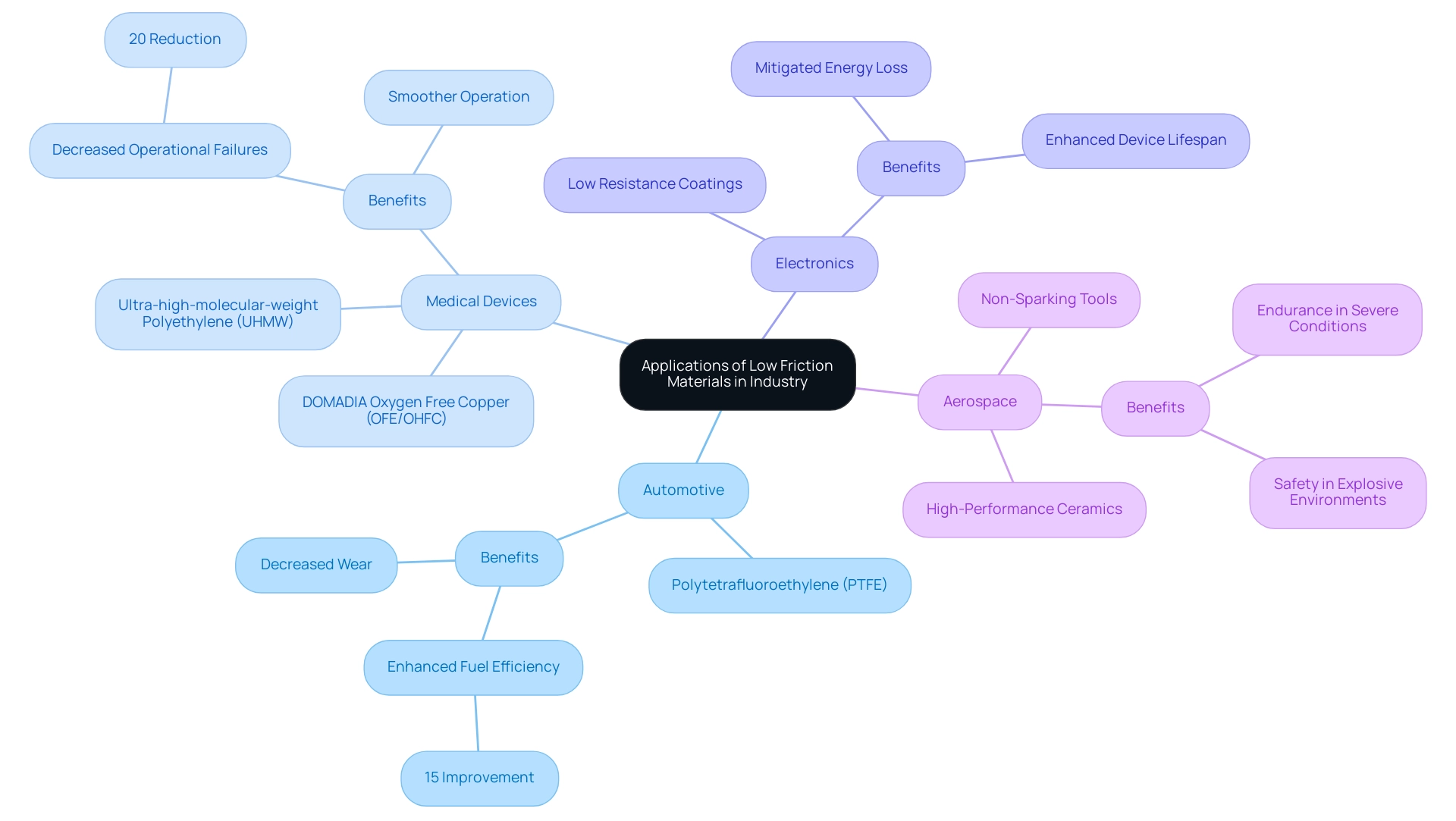
Benefits of Low Friction Materials: Enhancing Performance and Longevity
Low resistance substances offer considerable benefits in numerous applications, which can be summarized as follows:
- Lowered Wear – By employing low coefficient of friction materials, these substances significantly diminish wear on components, resulting in extended service life and lowered maintenance expenses. Statistically, the use of low resistance substances has been demonstrated to decrease wear rates by up to 40%, resulting in substantial financial savings over time. The efficiency of these low coefficient of friction materials can be further confirmed via the pin-on-disk wear test (ASTM G99), which assesses wear volume and resistance under controlled conditions.
- Enhanced Energy Efficiency – Systems that utilize low coefficient of friction materials are often linked to improved energy efficiency, leading to reduced operational costs. Recent research has shown energy savings of up to 15% in machinery employing these substances, highlighting their significance in contemporary industrial uses. Furthermore, the density of lubricant at 313 K is 875 Kg/m³, which is a crucial element in assessing the performance of low resistance substances.
- Noise Reduction – The use of low resistance surfaces can result in a significant decrease in noise levels during mechanical operations, contributing to a quieter and more pleasant working environment. This is particularly important in sectors where noise control is essential for compliance and employee comfort.
- Improved Performance – Low-resistance substances are engineered to enhance system efficiency, facilitating increased speeds and smoother operations. As pointed out by Professor Seong Kim from Penn State, automotive systems, aeronautics, medical devices, advanced sensors, and computer components are just a few of the industries that would undoubtedly gain from the creation of any substance that reduces the wear and resistance of surfaces. This insight reflects a growing recognition of how low coefficient of friction materials can drive performance improvements across diverse industries. Moreover, the case study named ‘Inverse Hall-Petch Relation in High-Entropy Alloys’ emphasizes that CoCrFeMnNi high-entropy alloys display low wear rates because of the creation of a highly deformed surface with a nearly amorphous layer, additionally illustrating the efficiency of low-resistance substances in improving wear resistance.
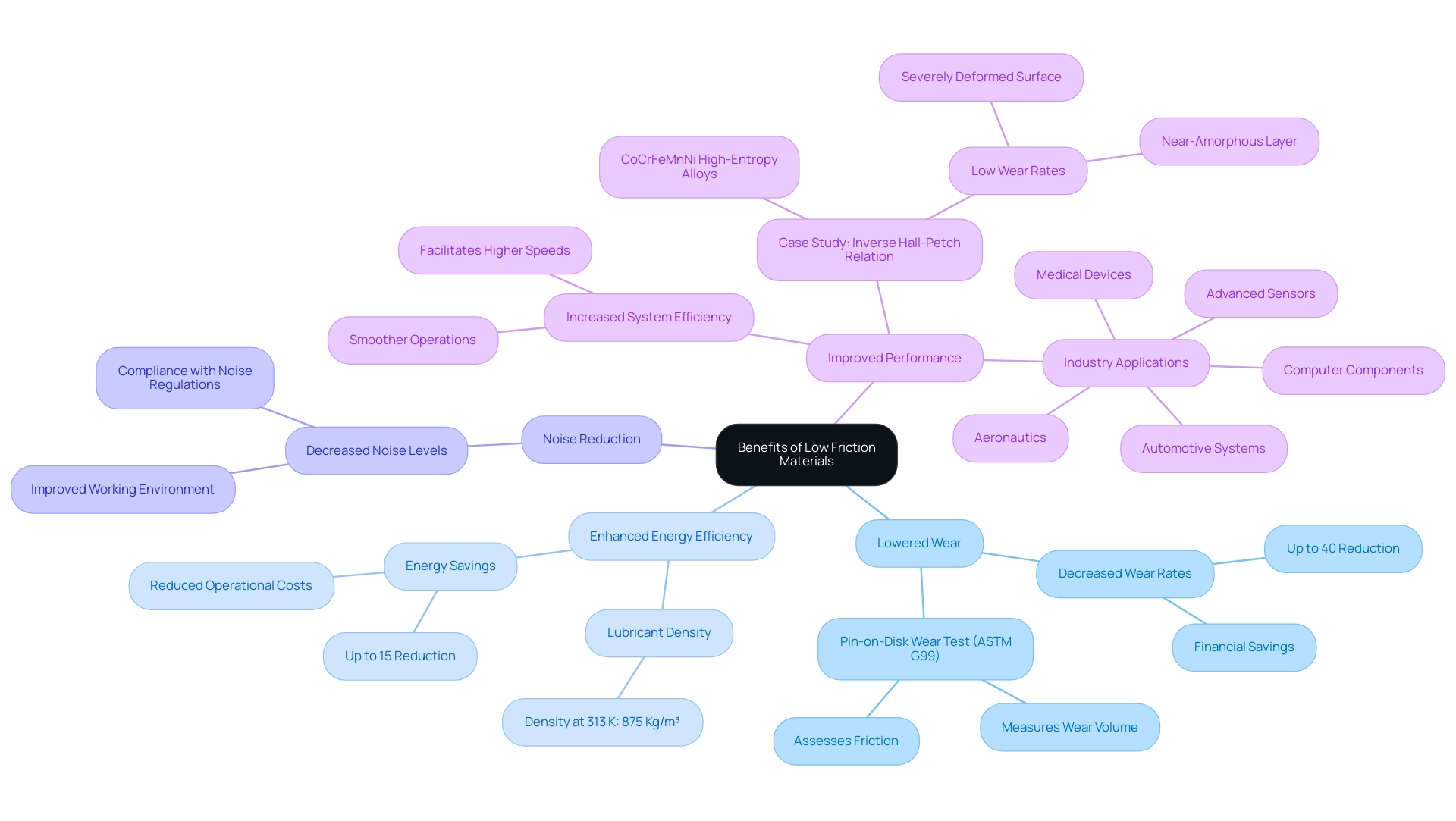
Challenges in Selecting Low Friction Materials: Key Considerations
Choosing low resistance substances entails addressing various essential obstacles that can greatly influence overall efficiency and affordability. First, compatibility is paramount; it is essential to ensure that the low resistance substance harmonizes with other components in the assembly. Misalignment can lead to performance issues that compromise the entire system.
Second, the cost versus performance dilemma requires careful evaluation. Not all low coefficient of friction materials provide the same benefits, and understanding the trade-offs between cost and performance characteristics is vital for making informed decisions.
Third, environmental conditions play a crucial role in selection. Factors such as temperature fluctuations, humidity levels, and chemical exposure can dramatically impact the performance of substances. Therefore, a thorough evaluation of the operational surroundings is essential, particularly when taking into account high-temperature uses where advanced substances such as mica tapes can offer exceptional insulation characteristics and fire resistance.
For instance, Mica Sheet Tape is particularly effective for insulating large flat surfaces in demanding environments, while Insulating Mica Tapes are essential for constructing coils and capacitors that require high-grade insulation.
Finally, supplier reliability should not be overlooked. It is essential to select suppliers who can consistently provide high-quality products, such as Mica Insulation Tape, which is designed for high-temperature resistance and electrical insulation, making it ideal for critical applications in electrical engineering. As mentioned by D. L. Burris,
The averaged resistance coefficient is mathematically identical to the interfacial resistance coefficient,
highlighting the need for precision in substance selection.
Studies indicate that coefficients of resistance and wear are reactions of a tribo-system instead of intrinsic substance characteristics, which increases complexity in the selection process. In the marine sector, for example, embracing superlubricity has proven to decrease resistance in ship parts, resulting in extended lifespans and improved efficiency. This not only results in significant fuel savings but also minimizes emissions, supporting a commitment to environmental sustainability.
By addressing these challenges, procurement managers can optimize selection for low coefficient of friction materials in low friction applications, ensuring compatibility and performance in engineering designs. According to the study published in Diam. Relat. Mater. 2018;87:172–176, understanding these dynamics can lead to better decision-making in material procurement.
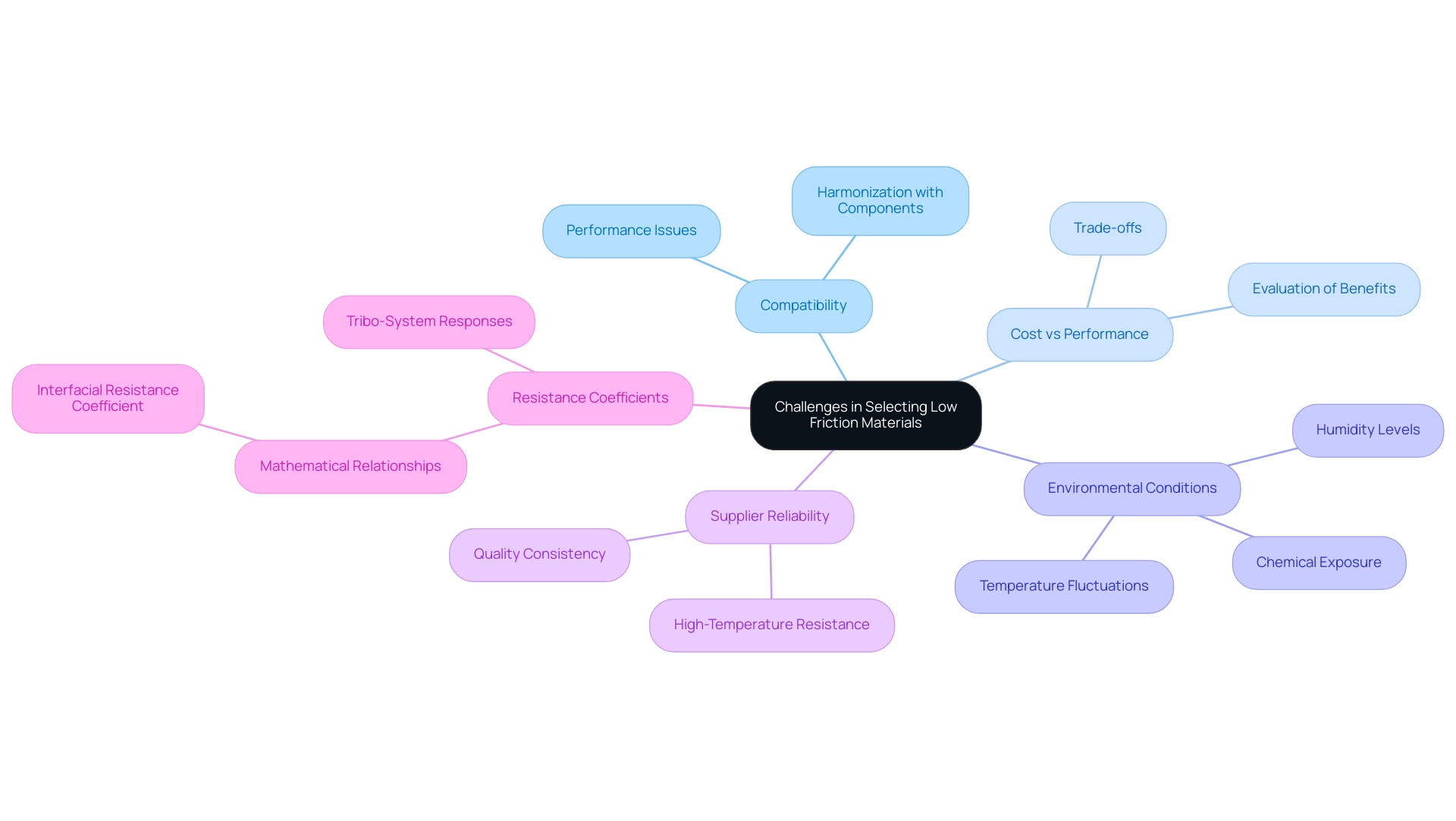
Conclusion
Low friction materials are integral to advancing efficiency across various industries, from automotive to aerospace. Their ability to minimize friction not only enhances mechanical performance but also extends the lifespan of components, leading to substantial cost savings. The exploration of materials such as PTFE, UHMW, and advanced ceramics highlights the diverse applications and significant benefits that these materials offer. By reducing wear and improving energy efficiency, they contribute to a more sustainable operational model, which is increasingly critical in today’s competitive landscape.
However, the selection of low friction materials is not without its challenges. Factors such as compatibility, environmental conditions, and supplier reliability must be carefully considered to ensure optimal performance. Procurement managers play a pivotal role in navigating these complexities, making informed decisions that align with both operational requirements and the latest advancements in material science. By prioritizing the right materials, organizations can drive innovation while also adhering to stringent safety and performance standards.
In conclusion, the strategic adoption of low friction materials is essential for organizations aiming to enhance operational efficiency and sustainability. As industries continue to evolve, understanding the intricacies of these materials will empower procurement managers to make decisions that foster innovation and ultimately contribute to long-term success. Embracing these advancements will not only improve performance but also support a commitment to environmental stewardship in engineering practices.




